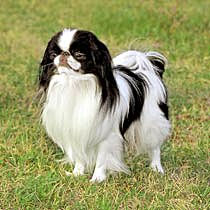Does a Black and White Japanese Chin and a Yellow Japanese Chin Make Black and Yellow Babies?
Japanese Chin
The Canine Chronicles Directory The Japanese Chins have a soft, silky coat with long feathering. The neck and chest is covered with thick hair. The coat colors are black/white, red/white or white with colored patches. These patches can be red, yellow, orange, sable, or brindle. Japanese Chins generally have a white spot in the middle of their foreheads. This has come to be known as "Buddha's Thumbprint" and is attributed to Emperor Ming of Han China, who owned many of these dogs. The short, broad muzzle has a well-defined stop. The forehead is round and the muzzle is upturned. The protruding, almond-shaped eyes are dark, wide-set and has white coloring in the inner corners. The pendant ears are triangular in shape and the wide nose has open nostrils. The nose color should coordinate with the coat markings. For example: black and white color coated Japanese Chins should have black noses. The teeth should meet in a level or should form an undershot bite. The straight front legs should be fine-boned and the feathered tail should curve over the back.

Temperament Japanese Chins are elegant, lively, playful, sensitive and happy dogs. They are affectionate, loving and loyal towards their owners. This breed loves everyone, although they are suspicious of strangers. Since this breed is small and delicate, children must be very gentle with this dog. They may be better suited with older children. They are generally good with other dogs and household pets. Japanese Chins are independent and have a mind of their own. They also love being the center of attention. This breed keeps very clean and uses their paws to wash their faces. This breed prefers to be surrounded by familiar areas and becomes uncomfortable in new or unknown situations. They have a deeper bark compared to other toy breed but overall they are a quiet breed. Since they are active and alert, they make great watchdogs. Height, Weight Height: 7-11" ; Weight: 4-15 lbs. Health Problems Like most short-muzzled dogs, the Chin can tend to snore and wheeze. They are prone to respiratory and eye problems and some are prone to distemper. Living Conditions Chins will do great with apartment living but need regular exercise. They are sensitive to weather extremes. Exercise This breed does not need a lot of exercise. They enjoy a daily walk and any opportunity to run off their lead. Life Expectancy Under 10 years Grooming This breed should be brushed or combed daily to keep the coat looking full and beautiful. Check often for matting. Check ears and eyes regularly for any signs of infection. Bathe only when necessary. This breed is an average shedder. Origin There are currently two possible theories on the origin of the Japanese Chin, ironically neither one of them include Japan. The first states that they were developed from a Pekingese-like dog in China and brought to Japan by Zen Buddhist monks. The other theory states that they descended from a lap dog given to the Emperor of Japan in the year 732 by a Korean diplomat. Despite how they got to Japan, once there, they became a favorite of the Japanese Court and were often used as royal gifts. Portuguese sailors first introduced this breed to Europe in the 1600s. They presented them to Catherine of Braganza who was the Queen Consort of King Charles II of England. In 1853, after negotiating a trade route to Japan, a pair of Japanese Chins were presented to American Naval Officer, Admiral Perry. He, in turn gave Queen Victoria and President of the United States Franklin Pierce, each a pair. Originally this breed was named the Japanese Spaniel, but in 1977 the AKC renamed them Japanese Chin. They are recognized by both the AKC and the UKC. Group AKC Toy, UKC Companion Dog
Does a Black and White Japanese Chin and a Yellow Japanese Chin Make Black and Yellow Babies?
Source: https://www.carealotpets.com/dog-breeds-AKC-JapaneseChin.aspx
0 Response to "Does a Black and White Japanese Chin and a Yellow Japanese Chin Make Black and Yellow Babies?"
Post a Comment